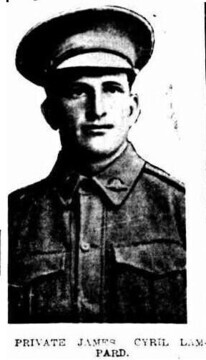LAMPARD, James Cyril
| Service Number: | 1975 |
|---|---|
| Enlisted: | 11 January 1915 |
| Last Rank: | Private |
| Last Unit: | 4th Division Headquarters |
| Born: | Balmoral, Victoria, Australia, 1893 |
| Home Town: | Balmoral, Southern Grampians, Victoria |
| Schooling: | Not yet discovered |
| Occupation: | Labourer |
| Died: | Melbourne, Victoria, Australia, 22 April 1979, cause of death not yet discovered |
| Cemetery: |
Springvale Botanical Cemetery, Melbourne |
| Memorials: |
World War 1 Service
| 11 Jan 1915: | Enlisted AIF WW1, Private, 1975, 7th Infantry Battalion | |
|---|---|---|
| 17 Apr 1915: | Involvement Private, 1975, 7th Infantry Battalion, --- :embarkation_roll: roll_number: '9' embarkation_place: Melbourne embarkation_ship: HMAT Hororata embarkation_ship_number: A20 public_note: '' | |
| 17 Apr 1915: | Embarked Private, 1975, 7th Infantry Battalion, HMAT Hororata, Melbourne | |
| 4 Oct 1917: | Transferred AIF WW1, Private, 4th Division Headquarters |
Help us honour James Cyril Lampard's service by contributing information, stories, and images so that they can be preserved for future generations.
Add my storyBiography contributed by Stephen Brooks
James Cyril Lampard was one of four sons of George and Mary Ann Lampard of Balmoral, Victoria who served with the AIF during WW1. All four brothers served mostly with the 14th Battalion.
James’s older brother, 1974 Pte. John Lampard 14th Battalion AIF died of wounds at sea off the coast of Gallipoli on 12 August 1915, aged 24.
Another older brother, 734 Pte. Glen Thomas Lampard, 14th Battalion AIF, was killed by a shell at Pozieres on 10 August 1916, aged 28. James Cyril Lampard and brother Gordon Lampard of the same unit were both wounded during the same action.
James enlisted with his brother John early in 1915 and both were assigned to the 7th Battalion with consecutive regimental numbers. They arrived on Gallipoli in mid-June 1915 and were both transferred to the 14th Battalion on 28 June 1915.
John was mortally wounded on 8 August 1915 and James was reported as wounded on the same date. He was evacuated to Malta with rheumatic fever during September 1915. He was in and out of hospitals for much of the time until the evacuation of Gallipoli. He was again reported wounded on 7 August 1916 at Pozieres with ‘shell shock’, but was back with his unit a month later.
In October 1917 James was transferred to 4th Division Headquarters and served right through until the end of the war. He was returned to Australia during March 1919.









